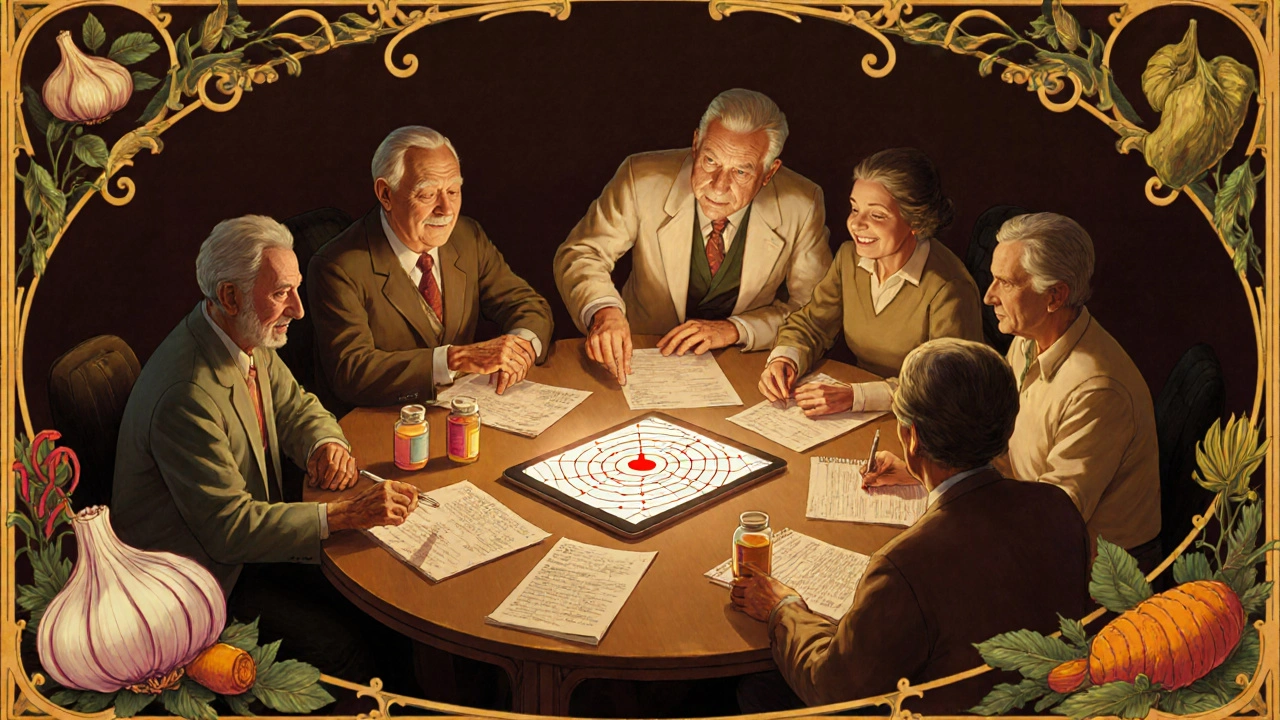Drug Interaction Simulator
How This Simulator Works
This tool simulates how drug interaction checkers work. Enter medications you take, and see how different combinations are flagged as interactions. This is educational only - it does not provide medical advice.
Interaction Results
Important Notes
1. This tool simulates interactions based on common examples. It does not provide medical advice. 2. Always consult your pharmacist or doctor before changing medications. 3. Include all medications, supplements, and OTC drugs. 4. Interaction severity depends on dosage, timing, and individual health factors.
Every year, hundreds of thousands of people end up in the hospital because of dangerous drug interactions. Many of these cases are preventable. If you're taking more than one medication - even over-the-counter pills, vitamins, or herbal supplements - you're at risk. A drug interaction checker isn’t just a fancy app. It’s a lifeline. Used right, it can stop a deadly combo before it starts.
What Exactly Is a Drug Interaction Checker?
A drug interaction checker is a digital tool that scans the list of medications you’re taking and flags combinations that could cause harm. These tools don’t guess. They use real pharmacology data - how drugs are absorbed, broken down, and cleared from your body - to predict what happens when two or more are mixed. For example, mixing warfarin (a blood thinner) with ibuprofen can raise your risk of bleeding. Or combining certain antidepressants with migraine meds can trigger serotonin syndrome - a potentially fatal condition. These aren’t rare. They happen daily. There are two main types:- Consumer apps like Medisafe, WebMD, or MyTherapy. These are simple, free, and designed for patients.
- Professional systems like Micromedex, Lexi-Interact, or DrugBank. These are used by doctors and pharmacists, integrate with hospital systems, and have deeper data.
Step 1: Gather Your Full Medication List
Before you open any app or website, get everything in front of you. Don’t rely on memory. Include:- Prescription drugs (even if you take them rarely)
- Over-the-counter painkillers (ibuprofen, acetaminophen, aspirin)
- Vitamins and minerals (especially vitamin K, calcium, iron)
- Herbal supplements (St. John’s wort, garlic, ginkgo)
- Energy drinks or weight-loss pills (yes, these count)
Step 2: Choose the Right Tool
Not all checkers are equal. Here’s what works best for most people:- For beginners: Medisafe (iOS and Android) - Simple interface, clean layout, and lets you save your meds in a digital “Med Cabinet.” It’s trusted by over 2 million users.
- For quick checks: WebMD Drug Interaction Checker - Free, no sign-up needed. Just type in two drug names and get results fast.
- For serious users: Epocrates (app or web) - Used by 80% of U.S. doctors. More detailed, but slightly more complex.
Step 3: Enter Your Medications Correctly
This is where most people mess up. Don’t type “aspirin.” Type “aspirin 81 mg.” Don’t write “fish oil.” Write “omega-3 fatty acids 1000 mg.” The tool needs specifics. Some apps let you scan barcodes. Use that. Others have dropdown menus. Pick the exact match - don’t just click the first one. For example, “Metformin” could mean 500 mg, 850 mg, or extended-release. Choosing the wrong version can lead to a false “no interaction” result. If you’re using Medisafe, tap “More,” then “Interactions Checker.” It will show your saved meds. Select the ones you want to compare. For WebMD, go to their site, click “Drug Interaction Checker,” type each drug in one at a time, then hit “Check Interactions.”
Step 4: Understand the Results
Results aren’t all “dangerous” or “safe.” They’re graded. Here’s what the colors and labels mean:- Red - Contraindicated: Don’t take these together. Risk of serious harm or death.
- Orange - Major: Could cause serious side effects. Needs doctor approval or dose change.
- Yellow - Moderate: Possible side effects. Monitor for symptoms.
- Green - Minor or No Interaction: Low risk. Still worth noting.
Step 5: Talk to Your Pharmacist - Don’t Just Rely on the App
Even the best checker misses things. Why? Because it doesn’t know your full story. - Are you a kidney patient? That changes how drugs are cleared. - Do you drink alcohol daily? That affects liver metabolism. - Are you over 65? Older adults are 3x more likely to have dangerous interactions. A 2022 study found that 61% of hospital staff ignored DDI alerts because they were too frequent or didn’t fit the patient’s real situation. That’s called “alert fatigue.” Your app might do the same. Always take your list - printed or on your phone - to your pharmacist. Ask: “Do any of these meds clash?” They’ll cross-check with professional tools and tell you what really matters.Common Mistakes People Make
- Only checking prescriptions - OTC meds and supplements cause half of all dangerous interactions.
- Assuming “natural” means safe - Kava kava can cause liver failure. Goldenseal interferes with antibiotics.
- Checking once and forgetting - Add a new painkiller? Re-check. Start a new vitamin? Re-check. Your meds change. Your checker should too.
- Ignoring the fine print - Some interactions only happen if you take them at the same time. Others need days to build up.

Real-World Example: What Happened When Someone Used It Right
A 72-year-old woman in Brisbane was taking lisinopril for blood pressure, omeprazole for acid reflux, and turmeric capsules for joint pain. She used Medisafe to check before her next doctor visit. The tool flagged a major interaction between omeprazole and turmeric. Both reduce stomach acid - together, they could cause nutrient malabsorption, especially vitamin B12. She didn’t know that. She told her GP, who switched her to a different acid reducer and cut the turmeric dose in half. No hospital visit. No bleed. No crisis. That’s the power of a simple check.What to Do If the Checker Says “No Interaction”
Still feel unsure? Go deeper. Try a second checker. If Medisafe says “no issue” but WebMD says “moderate,” trust the warning. A 2016 NIH study showed that using two tools together catches 30% more dangerous interactions than using just one. Also, search for the drug names + “interaction” on Google Scholar or PubMed. Look for studies from the last 5 years. If you see “increased risk of QT prolongation” or “hepatotoxicity,” don’t ignore it.When to Call Your Doctor Immediately
If you’ve taken a combo flagged as red or orange and notice:- Unexplained bruising or bleeding
- Rapid heartbeat, dizziness, fainting
- Severe nausea, vomiting, or yellow skin
- Confusion, hallucinations, or seizures
Final Tip: Make This a Habit
Set a reminder on your phone every 3 months to run your meds through a checker. Do it after holidays, when new prescriptions come in, or when you start a new supplement. Treat it like checking your car’s oil. You wouldn’t drive with a flat tire. Don’t take meds with hidden risks.Are drug interaction checkers 100% accurate?
No. Even the best tools miss 15-40% of interactions, depending on the drugs involved. They’re designed to catch the most common and dangerous ones, not every possible combo. That’s why you still need to talk to your pharmacist or doctor - especially if you’re on five or more medications.
Can I use a drug interaction checker for my pet’s medications?
No. Human drug interaction tools are built using human metabolism data. Pets process drugs completely differently. Always use a veterinary-specific tool or consult your vet. Giving your dog ibuprofen can be fatal, even if a human checker says it’s “safe.”
Do these tools check for food interactions?
Some do. Medisafe and WebMD include common food-drug interactions, like grapefruit with statins or dairy with antibiotics. But they don’t cover everything. If you’re on warfarin, avoid large amounts of leafy greens. If you’re on thyroid meds, wait 4 hours after eating before taking your pill. These aren’t always flagged - so ask your pharmacist about diet.
Is it safe to use free apps like Medisafe or WebMD?
Yes, if they’re from trusted sources. Medisafe is FDA-registered as a medical device in the U.S. WebMD’s tool is reviewed by licensed pharmacists. Avoid random apps with no clear developer or privacy policy. Always check if the app says it’s based on Lexicomp, Micromedex, or another reputable database.
What if my doctor says the interaction isn’t a problem?
Ask why. Sometimes, they’re right - maybe the dose is low, or you’ve taken it for years without issue. But if they dismiss it without explanation, get a second opinion. Your pharmacist is your best ally here. They see hundreds of these cases a week.


10 Comments
lol who even uses these apps? i just google my meds and hope for the best. also its not 'ibuprofen' its 'ibuprufen' lmao
The pharmacokinetic variables here are non-trivial. Many users overlook CYP450 enzyme modulation, especially with polypharmacy in geriatric populations. The tool’s utility is probabilistic, not deterministic. Always cross-validate with clinical context.
this is sooo helpful 😍 i literally just checked my cocktail of meds and found out my turmeric + omeprazole combo is a no-go. saved my life?? maybe. but definitely saved my stomach 🙏
bro i use epocrates every day at work. its the real deal. but for regular folks? medisafe is perfect. simple, clean, no ads. just type your pills and boom - you know what not to mix. seriously, do it. your liver will thank you 🙌
We assume technology solves human problems. But tools don't know your sleep schedule, your alcohol intake, your kidney function. They flag patterns. You have to interpret them. The real safety net is the pharmacist who remembers your name.
i tried webmd once and it said my fish oil and blood pressure med were fine but then i read a study that said omega-3s can amplify antihypertensives and make you dizzy. so now i double check everything. also i typoed 'acetaminophen' as 'acetaminoplen' and it still worked lol
I used to ignore yellow alerts. Then I got really dizzy after starting a new vitamin. Turned out it was the ginkgo + blood thinner combo. I thought it was just aging. Turns out it was my own negligence. Don't be like me. Check. Even if it's 'minor.' 🌿❤️
Man, I used to think herbal stuff was just ‘natural chill vibes.’ Then I found out my ashwagandha was messing with my thyroid med. Who knew? Now I treat every supplement like a prescription. Write it down. Check it. Ask your pharmacist. No shame in being cautious. Your body’s not a lab rat.
This guide is too long. You don’t need a step-by-step. Just don’t mix stuff. Also, ‘St. John’s wort’ isn’t a ‘supplement,’ it’s a serotonin bomb. And why are you even taking 12 pills? Just stop. You’re fine.
I’m 68 and on 7 meds. I print my list every time I go to the pharmacy. My pharmacist now knows me by name. She caught a dangerous interaction between my antidepressant and a new OTC sleep aid. I didn’t even know it was a problem. She’s my hero. Never skip that step.